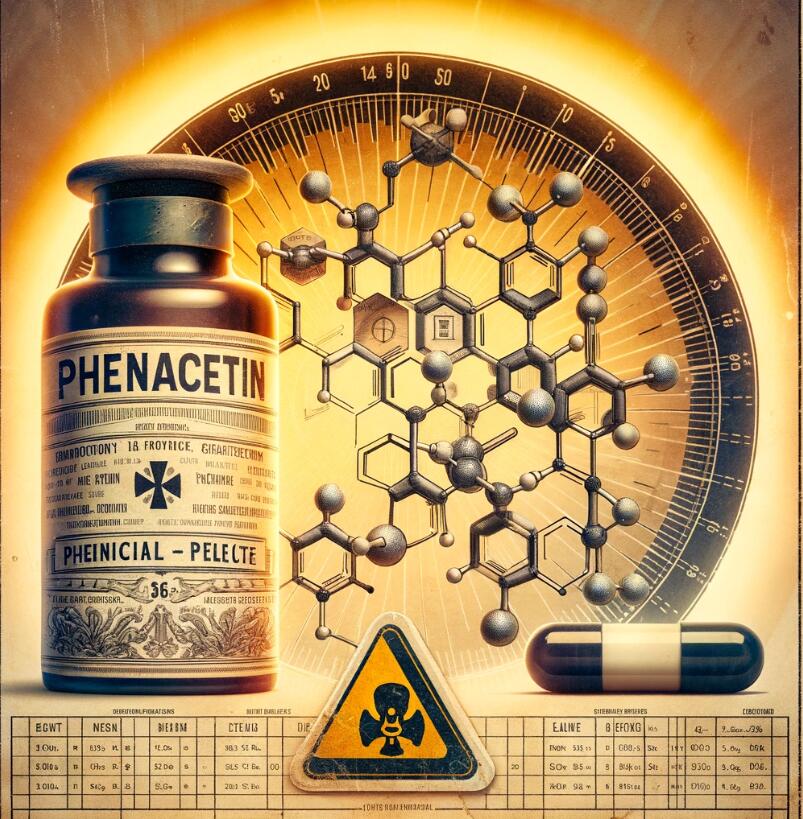Phenacetin Powder in Stores: Understanding Its Uses, Safety, and Alternatives
Phenacetin, once a popular analgesic and antipyretic, has a complex history marked by significant shifts in its usage and perception. This article explores the journey of Phenacetin, from its medical roots to its contemporary use. It provides information on its availability, uses, and associated health concerns.
What is Phenacetin?
Phenacetin is a white, crystalline powder known for its analgesic and antipyretic properties. Chemically, it is an acetanilide derivative with the formula C10H13NO2. First synthesized in 1878, Phenacetin was widely used in prescription and over-the-counter medications for pain relief and fever reduction.
Phenacetin became popular for its effectiveness in relieving pain and reducing fever without causing significant side effects, distinguishing it from other analgesics used then. However, its long-term use revealed serious health risks, leading to a gradual decline in its medical application.

Current Availability
Today, the availability of Phenacetin in stores and online markets is largely restricted. Its legal status varies across countries, with many, including the United States, having banned its use in medicines due to its carcinogenic and nephrotoxic effects. Despite these regulations, Phenacetin can sometimes be found in various forms, such as powders or mixed compounds, particularly in online marketplaces that might not adhere to strict pharmaceutical standards.
In countries where Phenacetin is not banned, it is often sold under strict regulations. The compound is typically available in limited quantities, and buyers might need to fulfill specific criteria or possess a license to purchase it.
Uses of Phenacetin
Historically, Phenacetin was widely used in various over-the-counter medications for its pain-relieving and fever-reducing qualities. It was a key ingredient in the popular analgesic combination known as APC (Aspirin, Phenacetin, Caffeine), used extensively until the late 20th century.
Today, the non-medical uses of Phenacetin have gained traction. While its legitimate medical use has declined significantly due to safety concerns, Phenacetin has found a niche market. Some users seek it for its mild euphoric effects, though such uses are not only illegal but also highly dangerous due to the compound's toxic nature.
Despite its known risks,
The continued demand for Phenacetin concerns healthcare professionals. This demand highlights the ongoing challenge of regulating and educating about hazardous substances available in stores or online.
Health and Safety Concerns
The safety concerns associated with Phenacetin are significant and well-documented. Long-term use of Phenacetin has been linked to various health issues, most notably nephropathy (kidney damage), which can lead to end-stage renal disease. Additionally, Phenacetin is classified as a carcinogen, with studies indicating a heightened risk of several types of cancer, including kidney and bladder cancer.
These health risks prompted a reevaluation of Phenacetin's role in medicine. By the 1980s, many countries had begun phasing out Phenacetin from over-the-counter medications, culminating in its ban in several regions. Health authorities have limited the use of a particular substance due to warnings about its negative effects, and they have emphasized the need for safer alternatives.
Despite these efforts, the illicit availability of Phenacetin poses ongoing risks. Consumers purchasing compounds from unregulated sources might inadvertently expose themselves to Phenacetin, underscoring the importance of vigilance and awareness when buying medications or supplements.
While Phenacetin's historical significance in medicine cannot be understated, its current status is a testament to the evolving understanding of drug safety and efficacy. To make safer health choices, consumers and healthcare providers must remain informed about such substances, their legal status, and associated health risks.
Alternatives to Phenacetin
The use of Phenacetin, a pain and fever relief medication, has been associated with significant health risks, leading to the search for safer alternatives. Modern medicine offers a variety of options that are effective and have fewer side effects. Over-the-counter medications like acetaminophen (paracetamol) and ibuprofen are commonly recommended for pain and fever. These drugs work similarly to Phenacetin in terms of pain relief and fever reduction but are much safer when used as directed.
Aside from pharmaceutical options, there is a growing interest in herbal and natural remedies. Ingredients like ginger, turmeric, and willow bark have been used historically for their analgesic properties and are gaining popularity. While these natural alternatives can be effective, consumers must consult healthcare providers before using them, especially if they already take other medications or have existing health conditions.
Consumer Awareness and Education
Consumer awareness is vital in making informed choices about health products. Consumers need to understand how to read labels and identify potentially harmful ingredients like Phenacetin in products. Educating oneself about unregulated substances' legal implications and health risks is also crucial.
Healthcare providers and pharmacists are key to this education. They can provide valuable advice on the safe use of medications and guide patients toward effective and safer alternatives. Public health campaigns and educational resources raise awareness about risks associated with certain substances and the importance of buying from reputable sources.
The Future of Phenacetin in Stores
The future of Phenacetin in stores is uncertain. Given its legal status and health risks, it's likely that the compound will remain restricted or banned in many countries. However, the continued existence of niche markets and online platforms where Phenacetin might be sold poses ongoing challenges.
Advancements in drug safety and regulation, along with increased public awareness, could lead to a further decrease in Phenacetin's availability and use. Continuous research offers new insights into its effects, potentially influencing future regulatory decisions.
In summary, Phenacetin's journey from a widely used analgesic to a substance of concern highlights the dynamic nature of drug safety and public health policy. The change in how Phenacetin is used and perceived highlights the significance of continuous research, regulation, and education to ensure the safety and welfare of consumers. As medical science and public health awareness continue to progress, the history of Phenacetin serves as a reminder of the importance of being vigilant and making informed decisions in healthcare.

References and Further Reading
This article is based on various scholarly articles, historical documents, and current regulatory guidelines. For additional resources, it is recommended that readers refer to medical journals, official health agency websites, and publications on medical history.
- Company info
- About US
- Send Inquiry
- News
- FAQs
- sitemap
- User Center
- Tracking Order
- Forget Password
- My Orders
- My Account
- Register
- Join our community
Copyright © 2020-2023 BenzocaineSupplier.com All Rights Reserved.
